Healing Body and Soul:
The Magic of the Forests
Mei Kuo / photos by Jimmy Lin / tr. by Brandon Yen
June 2024

A mass of Persicaria thunbergii carpets a cypress forest in the Alishan National Forest Recreation Area. We feel as if there were fairies hidden among the greenery who might jump out at any moment to dance with us.
Taiwan is a green island. Over 60% of its territory is covered with forest. With a total land area of just 36,000 square kilometers, Taiwan boasts 268 mountains taller than 3,000 meters. This density is staggering even from a global perspective.
The forests that grow on Taiwan’s majestic mountains provide shelter for a dazzling variety of flora and fauna. Alishan in Chiayi County is particularly noteworthy for its abundance of Taiwan red cypresses (Chamaecyparis formosensis)—an endangered species endemic to Taiwan. Let us take the time to follow forest guides and therapists and immerse ourselves in the healing sensuousness of Taiwanese woodlands.
“Choose a tree and lean against it.” “Feel the air passing through your nostrils.” “Pick up a fallen leaf next to you, put it on your palm, rub it, and then smell it.” “Listen to the sounds around you.” “Finally, shuffle in circles gently, until you find yourself facing in a direction you feel comfortable with.” “Slowly open your eyes and pay close attention to the gifts of nature laid out before you.”
We’re on the mahogany avenue in Xinwei Forest Park, in Kaohsiung’s Maolin National Scenic Area. Juna Chang speaks softly, inviting the forest guides she is training to attune their senses to the green surroundings. A forest therapy guide and trainer of forest therapists, Chang is the first Taiwanese to gain certification from the Association of Nature and Forest Therapy Guides and Programs in the US.
The trainees share their thoughts after the immersive session: “I come here two or three times a week. My previous visits were rather rushed, but today I was able to close my eyes and listen carefully to the rustle of falling leaves.” “When I opened my eyes I felt the sun giving off a gorgeous light, like glass beads.” “I’ve always wanted to hug trees, but I didn’t want to be taken as a weirdo. Today I finally got close to a tree. I’m grateful for its beauty, which changes with the seasons.”
Places of repose
Yu Chia-pin is a professor in the School of Forestry and Resource Conservation at National Taiwan University and director of the Taiwan Forest Therapy Society. He says the word “forest” suggests “for rest”—reminding us that forests are places that promise repose. Over the past two centuries, industrialization has exacerbated environmental pollution and made life more stressful, giving rise to so-called diseases of affluence. Scientific evidence reveals that the oxygen-rich air in forests, the phytoncides emitted by plants, and the negative ions generated through friction between water droplets and the air can help us calm down and reduce our fatigue, thus supporting our physical and mental health.
However, the therapeutic benefits of forests are not immediately accessible to everyone. Yu observes that because modern people have become so habituated to the virtual worlds of electronic devices, they need the guidance of forest therapists to fully connect with the physical environment and to be able to unwind in nature.
Forest therapy can be regarded as a niche type of tourism that helps us experience “slow living.” Chang describes it as a process whereby attendees extricate themselves from the rapid pace of modern life and attune themselves to things in the here and now, gradually repairing their relationships with other people and with the natural environment. This process may even inspire creative ideas. But how do we know whether we have been healed by a forest? Chang says the therapeutic effects become evident when we measure our heart rate and blood pressure or swap notes afterwards.
Forest therapy is enjoying a global boom, being promoted in countries like Japan, South Korea, the US, and Germany as a form of preventive healthcare or complementary medicine. Straddling tropical and subtropical ecosystems, Taiwan has distinct advantages in this context. Its terrain is remarkably varied, interspersed with many high mountains. Some 60% of the territory is covered with forest, ranking seventh in Asia. With a total land area of 36,000 square kilometers, the island has 268 peaks that rise above 3,000 meters—such a density is extremely rare across the world. Taiwanese woodlands are home to a vast variety of flora and fauna, inviting us to slow down and experience their therapeutic power.
In recent years, the Forestry and Nature Conservation Agency (FANCA) has launched a certification program for forest therapists. A total of 45 practitioners have been accredited since 2023. Of Taiwan’s 18 national forest recreation areas, eight—Taipingshan, Dongyanshan, Baxianshan, Aowanda, Alishan, Shuangliu, Zhiben, and Fuyuan—have been selected as demonstration sites for forest therapy based on their biodiversity, environmental conditions, footpaths and other facilities, accessibility, convenient accommodation, and cultural diversity.
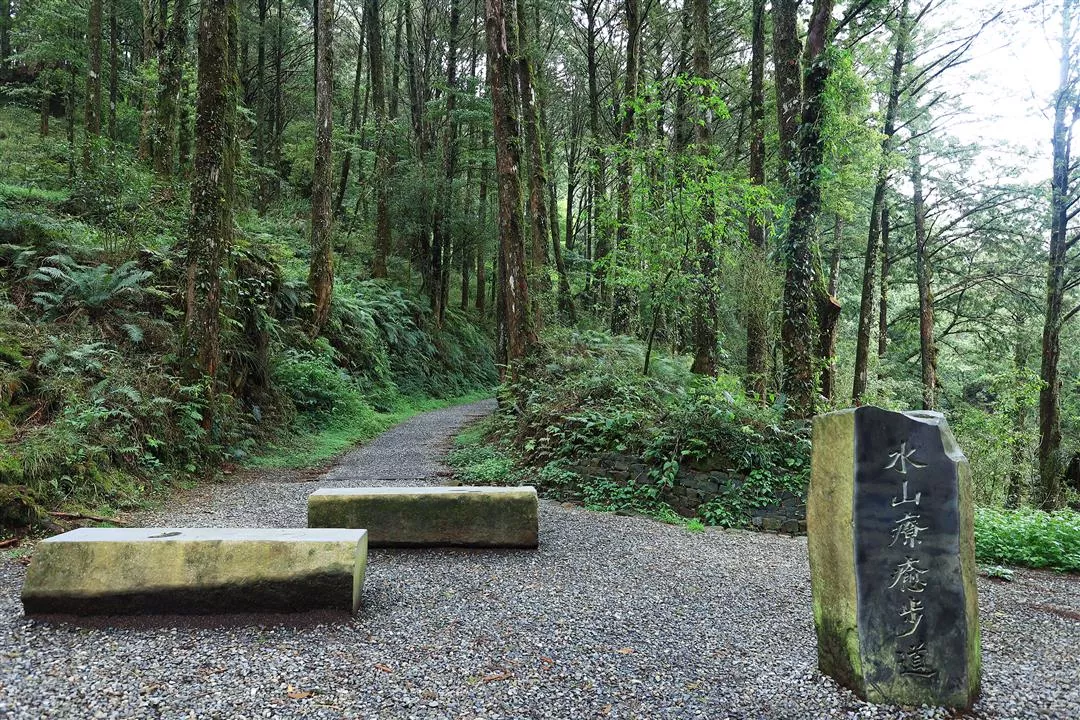
The Shuishan Healing Trail is the first trail in Taiwan to be dedicated to forest therapy.
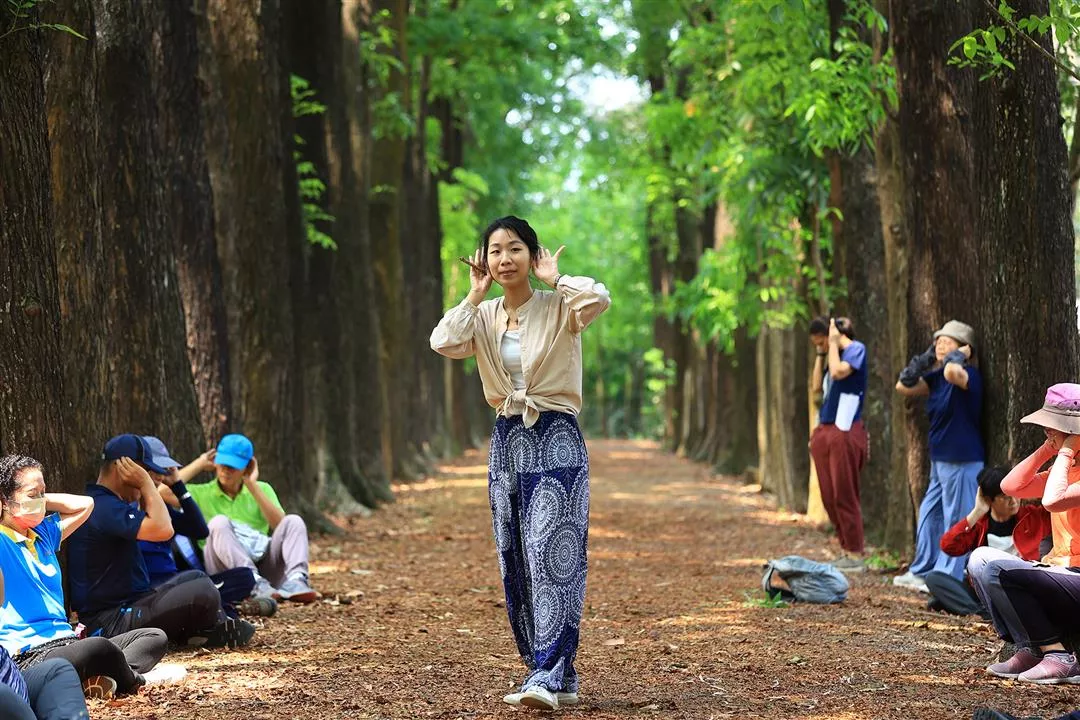
Juna Chang, a forest therapy guide and instructor, invites us to sharpen our senses and attune ourselves to the green environment.
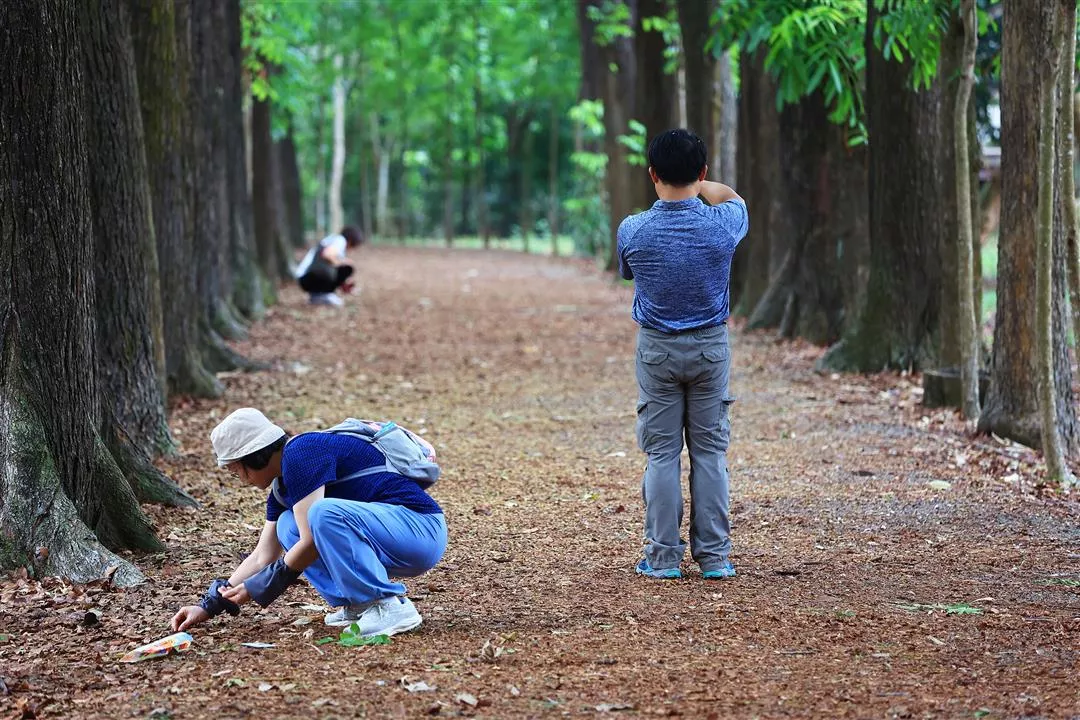
Looking for “rainbows” in a forest! Can you find objects that represent all the colors of the rainbow?
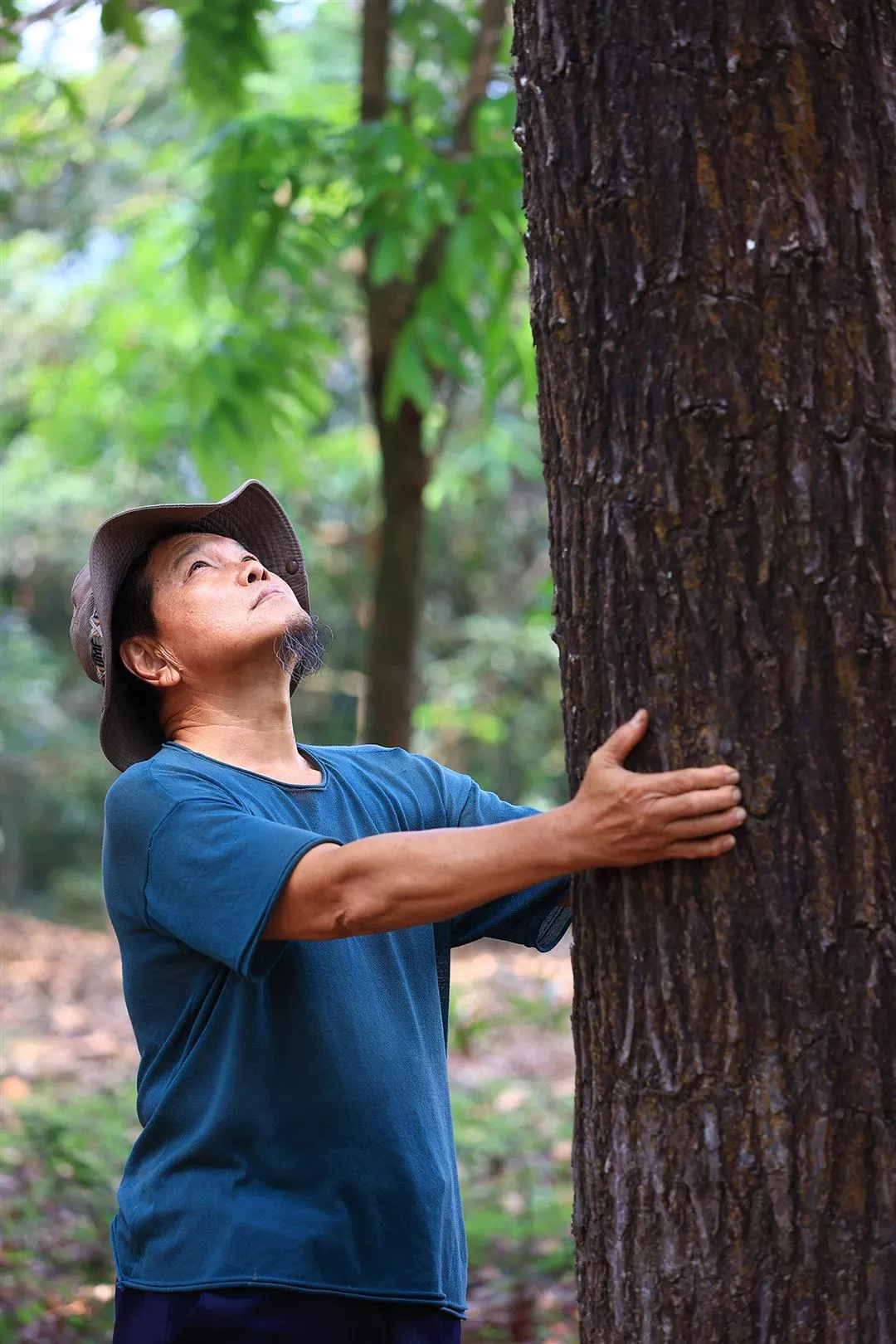
Let’s embrace the therapeutic power of forests and learn from nature.
The Shuishan Healing Trail
In the Japanese colonial era, Alishan, Taipingshan, and Baxianshan—where cypresses grew in abundance—were Taiwan’s three greatest logging grounds. David Sheng-yang Wang, distinguished professor of forestry at National Chung Hsing University, tells us that Taiwan’s “false cypresses,” in the genus Chamaecyparis of the cypress family (Cupressaceae), are relict species from the ice ages. Of the world’s six to seven remaining Chamaecyparis species, Taiwan has two: the Taiwan red cypress (Chamaecyparis formosensis) and the Taiwan yellow cypress (Chamaecyparis obtusa var. formosana).
False cypresses are found mainly in warm temperate regions. Though Alishan lies within the tropics, much of the Alishan Range stands higher than 2,000 meters above sea level, shrouded in mists and clouds year round. The well-preserved forests here abound with Taiwan red cypresses. In Alishan’s humid environment, wood easily releases monoterpene phytoncides. Throughout the year, every cubic centimeter of air here contains upwards of 1,000 negative ions. Visiting Alishan can help lower our blood pressure, relax our minds, and relieve stress and anxiety. This is an ideal place for forest therapy.
At Alishan it was the wealth of cypresses that led to the creation of the forest railway, now celebrated alongside the other “wonders” of the place: ancient trees, seas of clouds, sunrises, and sunsets. The giant trees here are known across the world, making Alishan the most famous, popular, and representative forest recreation area in Taiwan.
Alishan’s richly diverse forests are among the traditional homelands of the indigenous Tsou people. With its high elevations and special climate, Alishan produces mountain teas and coffees that attract connoisseurs from far and wide.
Taking advantage of Alishan’s history, culture, and geography, FANCA has established the Shuishan Healing Trail, the first of its kind in Taiwan. Measuring 863 meters long, the trail winds its way along a relatively level contour. Visitors revel in the endless views of luxuriant cypresses here.
The Chiayi branch of FANCA commissioned forest therapist Paul Lin, a board member of the Taiwan Forest Therapy Society, to lay out the Shuishan Healing Trail together with a team of designers. The four therapeutic zones along the trail invite us to engage in four different activities: closing our eyes, taking deep breaths, unburdening ourselves, and lying down on our backs. Each zone has an information post that uses Bluetooth technology to convey details to visitors. Those who come to Shuishan for the first time can download the Alipedia app and practice the recommended therapeutic activities at their leisure.
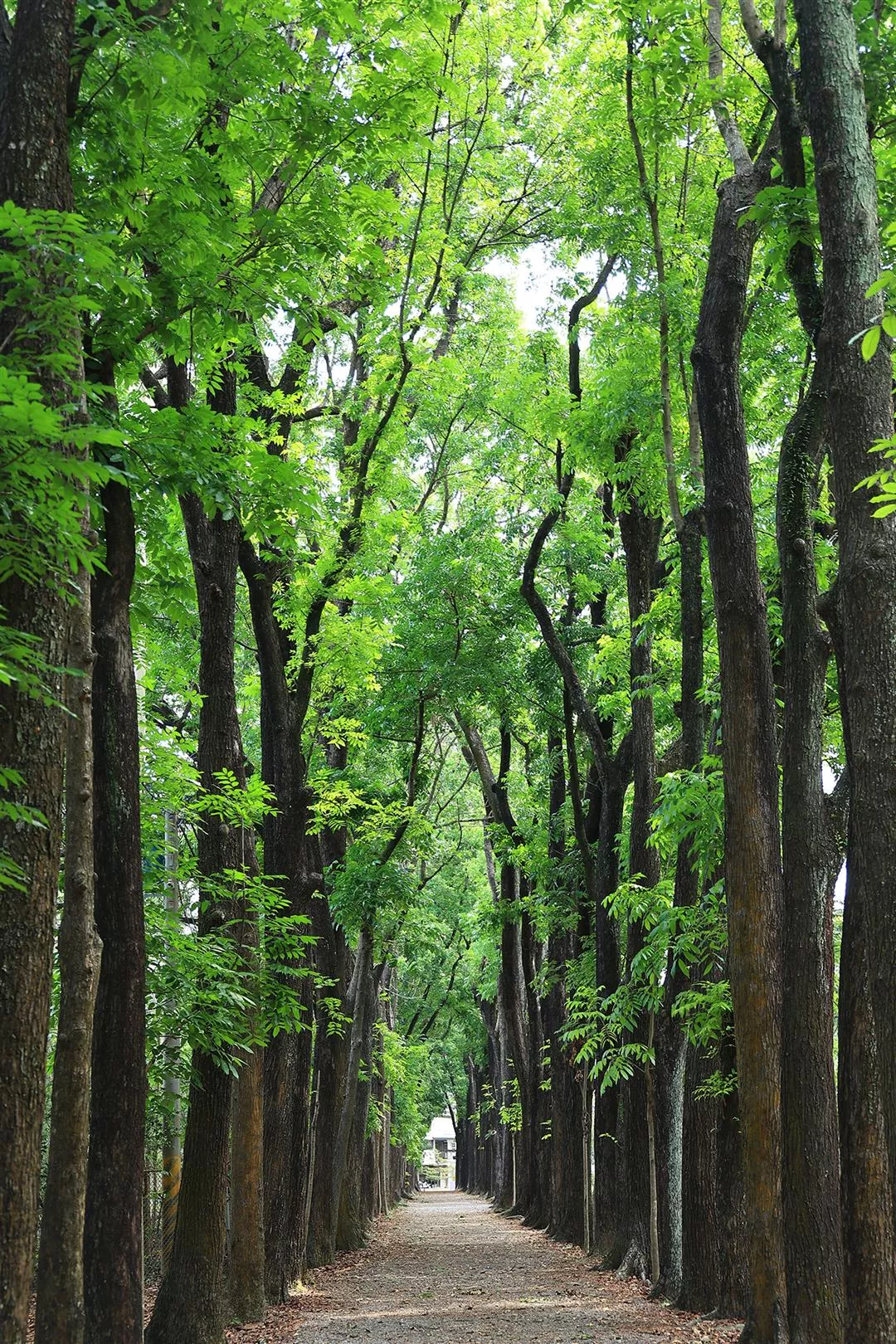
The mahogany avenue in the Maolin National Scenic Area’s Xinwei Forest Park is covered with fallen leaves, looking particularly picturesque.
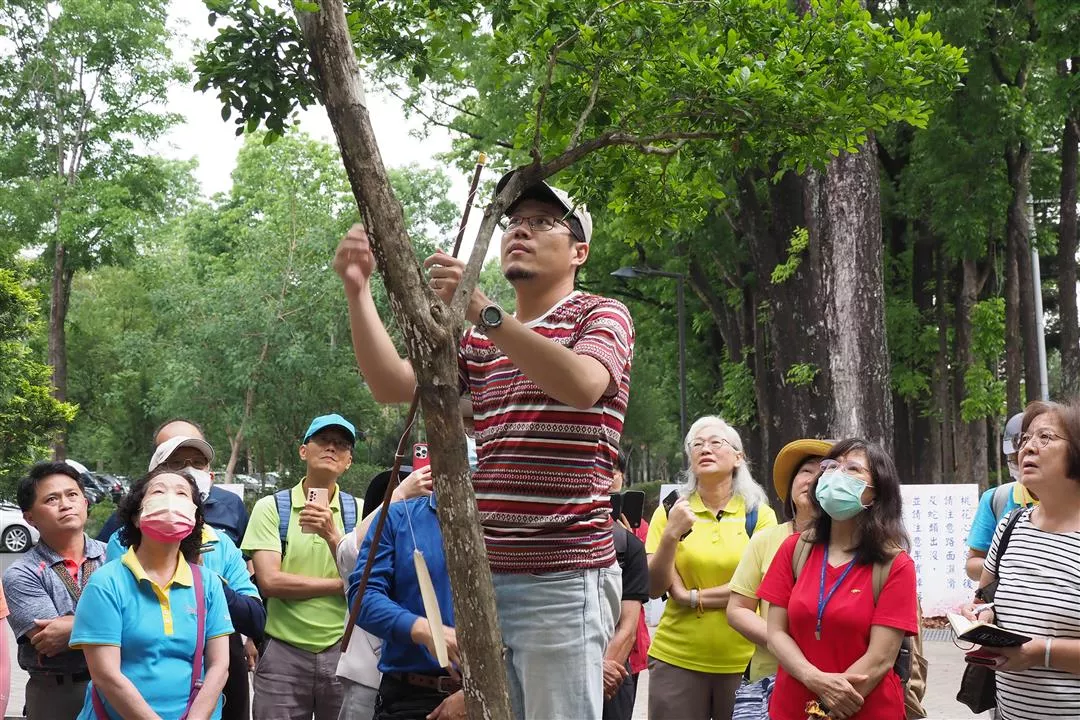
Yang Chih-kai (middle), an assistant professor of forestry at National Pingtung University of Science and Technology, trains future forest therapy guides to identify woodland plants.
A therapeutic journey
The time is early May, near the end of spring. Tourists are following the lead of Wang Senlin, a forest therapy guide, on their visit to the Shuishan Healing Trail.
The calls of birds such as Steere’s liocichla, Taiwan yuhina, white-eared sibia, and Eurasian nuthatch waft through the air, now far, now near, in boisterous conversation. We’re very near the Alishan Forest Railway’s Zhushan Station. A departing train whistles. “The more tranquil you are inside, the more clearly you’ll discern these tiny sounds,” Wang says.
Arriving at the zone named “Forest Seat,” we see a wooden platform, in front of which stand two cypresses. Here we are encouraged to fill our chests with a deep breath, and then breathe it all out. Inhaling the phytoncides produced by the trees here helps refresh our minds.
Thanks to a rainstorm the previous day, the leaves of the Thunberg’s fleece flowers (Persicaria thunbergii) that carpet the forest floor appear softer and more tenderly green. It’s easy to imagine fairies peeping at us with twinkling eyes through the mass of greenery. Or perhaps they may suddenly jump out to play tricks on us or dance with us.
Turning a corner, we arrive at the serene “Imagination Place,” where visitors can open their hearts to a hole in an elephant-shaped tree stump that sits prominently by the path.
Moving on to the zone dubbed “Silhouette of Trees,” we find a round platform, where tourists lie on their backs with open arms, gaze at the sky, and take in the blessings of the sun. “Here we lie down at an elevation of 2,400 meters, and imagine ourselves soaring above the treetops and hovering amid the clouds and mists. And we realize there’s always light at the end of the darkest tunnel,” Wang intones.
The end of the trail is marked by the 1081-year-old Shuishan Giant Tree. Travelers delight in the presence of this ancient Taiwan red cypress, resting on the observation deck nearby to marvel at its grandeur.
The phytoncides and negative ions in the forest can awaken our creativity and give us imaginative access to an infinite variety of tree shapes. Wang points out a tree named the Chieftain’s Cypress. The burls, mosses, and flaking bark on its trunk evoke the image of a chieftain with feathered headgear. “Wow, that’s exactly it!” “He looks so kind!” “There’s a man here! It’s so spooky.”
Rising above 2,000 meters, the mountains of Alishan form part of Taiwan’s cloud forest belt. As the afternoon mists rise over the slopes, the fleeting gaps that open up among the ever-shifting clouds are penetrated by sunbeams that strike shafts of glowing light through the moist air.

In spring, we come across gorgeously purple foxgloves everywhere on Alishan.
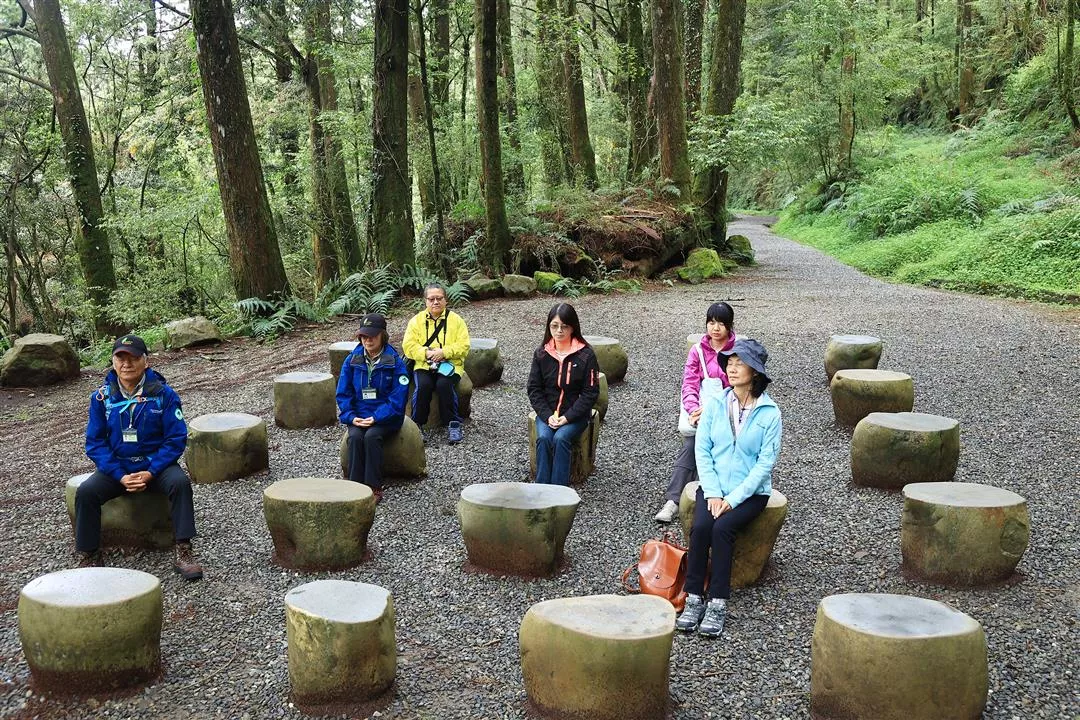
The “Shuishan Forest Classroom” is one of the four therapeutic zones along the Shuishan Healing Trail. Visitors can rest on the stone seats here to meditate and search for peace of mind.
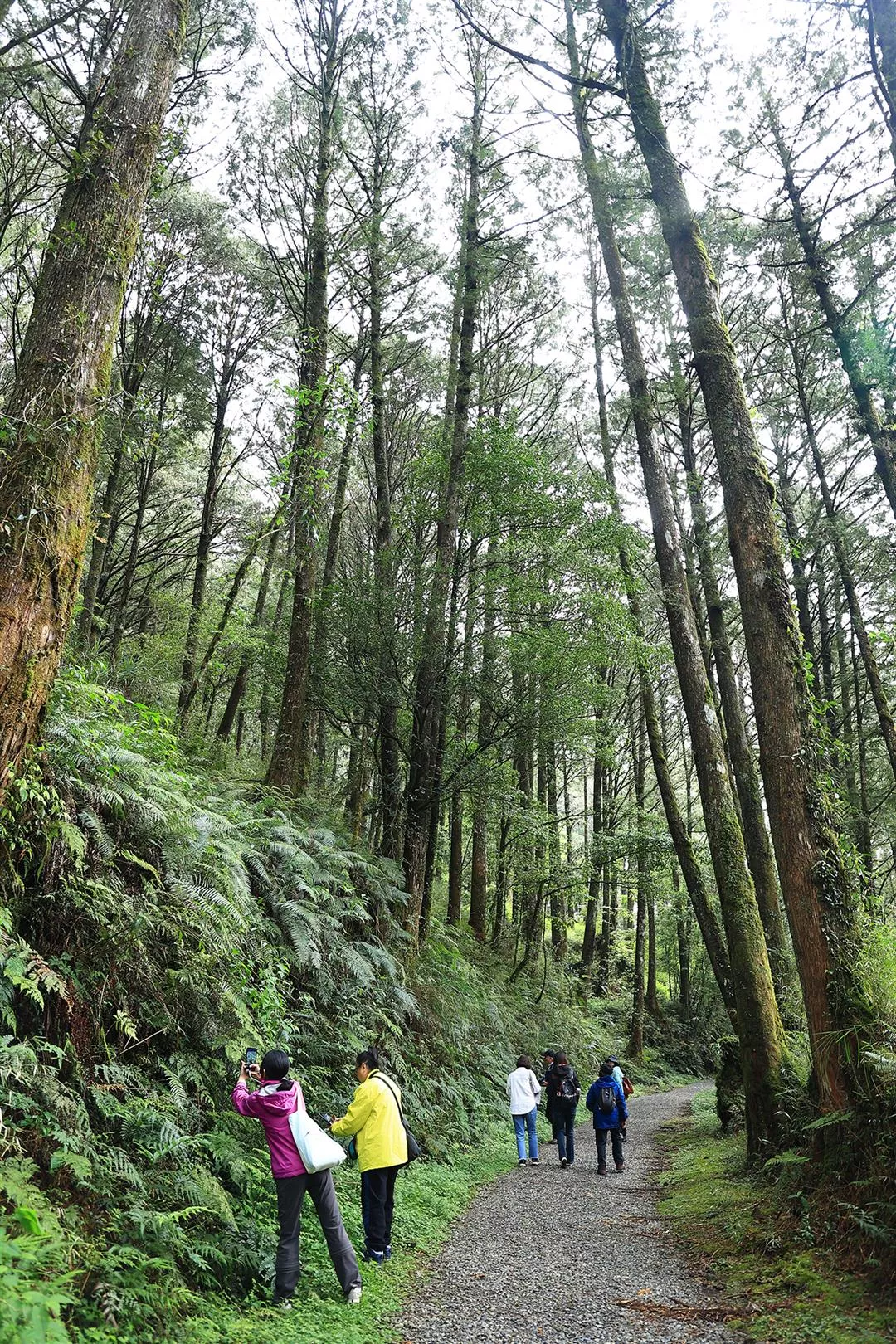
Alishan boasts a great diversity of flora and fauna, promising therapeutic benefits at every turn.
Alishan’s botanic garden
Between Zhushan Station and the Mt. Ogasawara (Xiaoliyuanshan) Observation Deck lies the Alpine Botanical Garden, which FANCA has turned into a venue for forest therapy. The garden has a great variety of flora and fauna, winding paths with stone steps, viewing platforms, and a wooden building. If we’re in luck, we may see shy Mikado pheasants foraging here in pairs at dawn or at dusk.
The first floor of the wooden building in the garden can be used for activities such as yoga, tea ceremonies, and forest therapy workshops. The second floor offers authentic local food and drinks, including mountain tea, coffee, and vermicelli with Alishan camellia oil. Here visitors get to experience the soul of Alishan in a visceral way.
A staff member tells us: “There was a thunderstorm on Alishan yesterday. We thought no-one would come, but as it turned out, we had tourists from the Netherlands, Germany, and New Zealand who didn’t mind the torrential rain. They sat here all afternoon and didn’t want to leave.”
Forests in Taiwan give off enchantingly intoxicating scents. FANCA has used the fragrance of the Taiwan incense cedar (Calocedrus formosana) as a base note to develop three types of “forest parfum,” featuring herbal, fruity-floral, and woody scents. This is one of the “Five Conifers of Taiwan,” the others being the Taiwan red cypress, the Taiwan yellow cypress, Taiwania cryptomerioides, and the Luanta fir (Cunninghamia konishii). FANCA has also launched its own cultural brand, Alishan 2488m, with a shop at Alishan Transport Station selling a diverse range of creative products made of wood and capturing the fragrances of Taiwanese woodlands.
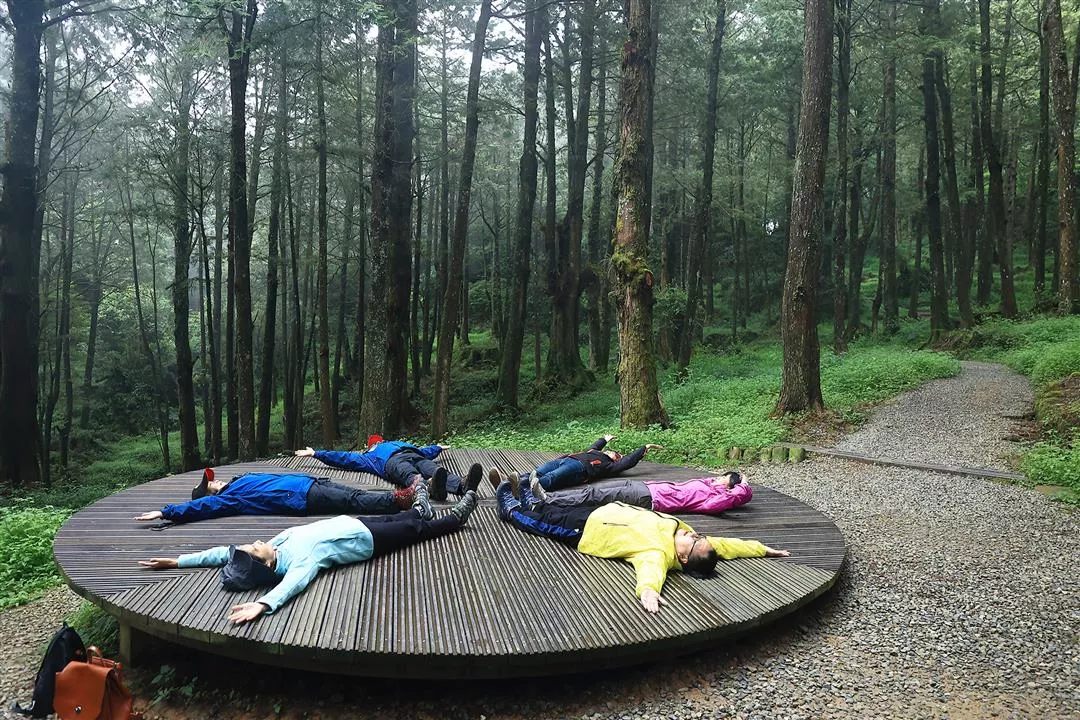
Tourists lie down to bask in the sun on the round platform of the Shuishan Healing Trail.
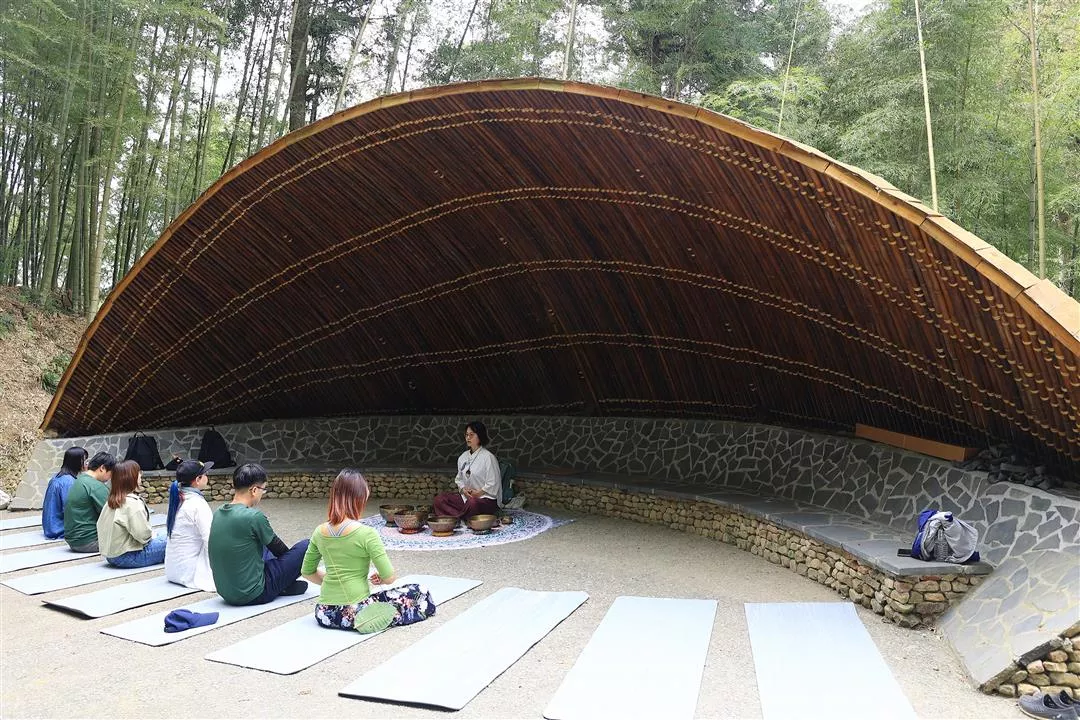
This scenic bamboo structure at Shibi in Caoling Village, Yunlin County offers a therapeutic space in the midst of a bamboo grove.

Visiting Alishan gives us insights into the history of Taiwan’s timber industry.

FANCA’s shop Alishan 2488m displays wooden figurines of various kinds of workmen in the local industries.
The magic of the forests
Taipingshan National Forest Recreation Area in Yilan is also an ideal venue for forest therapy. Far from the din of cities, Taipingshan’s Cuifeng Lake Circular Trail was designated as the world’s first “Quiet Trail” by Quiet Parks International in 2022. The cypress forest here is carpeted with thick layers of moss, which absorbs noise effectively: the lowest sound levels in the forest are below 25 decibels. FANCA director general Lin Hwa-ching says: “This place is very healing even if we just meditate or do nothing while listening to the voice of nature.”
Following the Fenggang River upstream at Pingtung’s Shuangliu National Forest Recreation Area, we arrive at Shuangliu Falls. Once voted the second most beautiful waterfall in Taiwan, the place is another rich source of negative ions and fresh air. Likewise, at Zhiben National Forest Recreation Area in Taitung, the big-leaf mahogany forest and the visitor center offer an abundance of negative ions, two to eight times more than in urban areas. Here, the limpid streams, indigenous cuisine, and hot springs all help visitors relax and recharge.
If we ever feel that something is stirring in the forest, it is most likely our own heartbeats.
Actions speak louder than words. Let’s step out of our comfort zones and visit the forests to catch the scents of flowers and trees, witness the ever-changing patterns of light and shade, listen to the murmurs of leaves and branches, and feel the gentle kisses of the wind. Let the magic of Taiwanese forests wash over our bodies and souls!
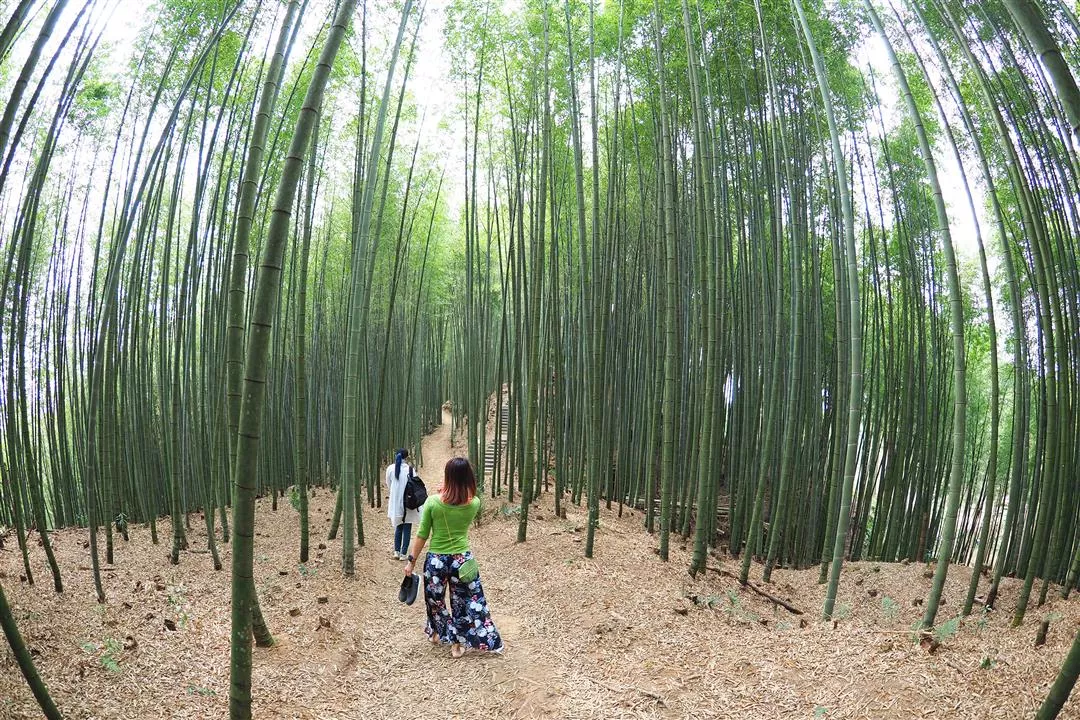
Shibi in Yunlin’s Caoling is the first site in Taiwan to promote the therapeutic power of bamboo groves.
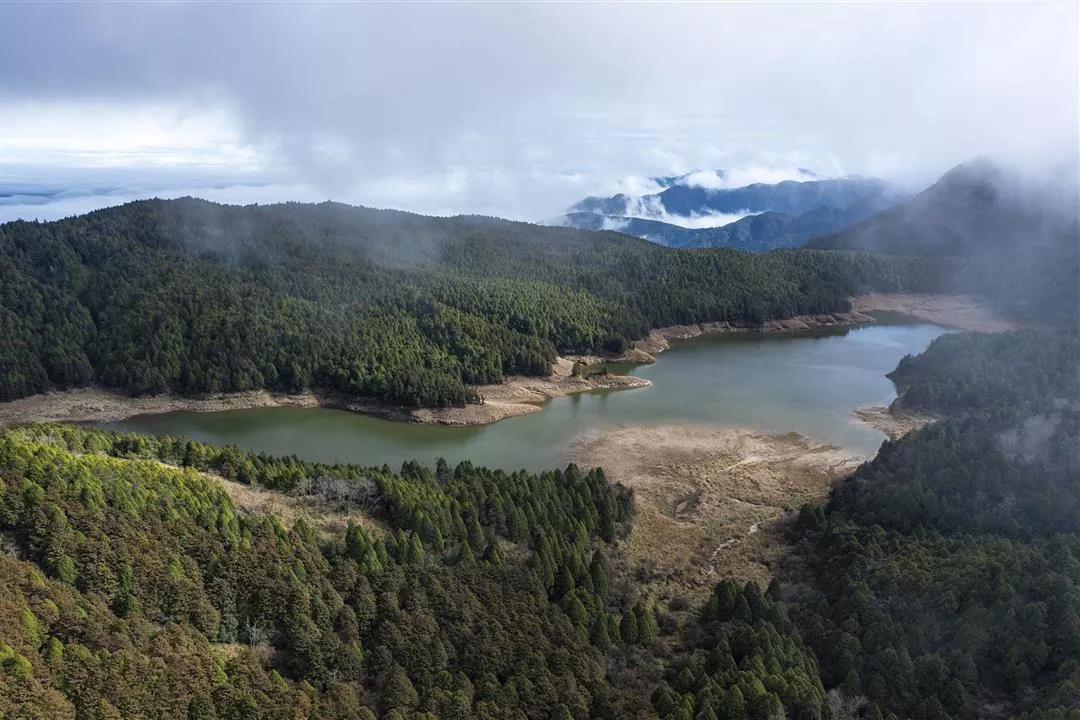
Taipingshan’s Cuifeng Lake is known for its tranquil environment. Tourists enjoy meditating here while listening to the sounds of nature. (photo by Kent Chuang)



@List.jpg?w=522&h=410&mode=crop&format=webp&quality=80)



@List.jpg?w=522&h=410&mode=crop&format=webp&quality=80)